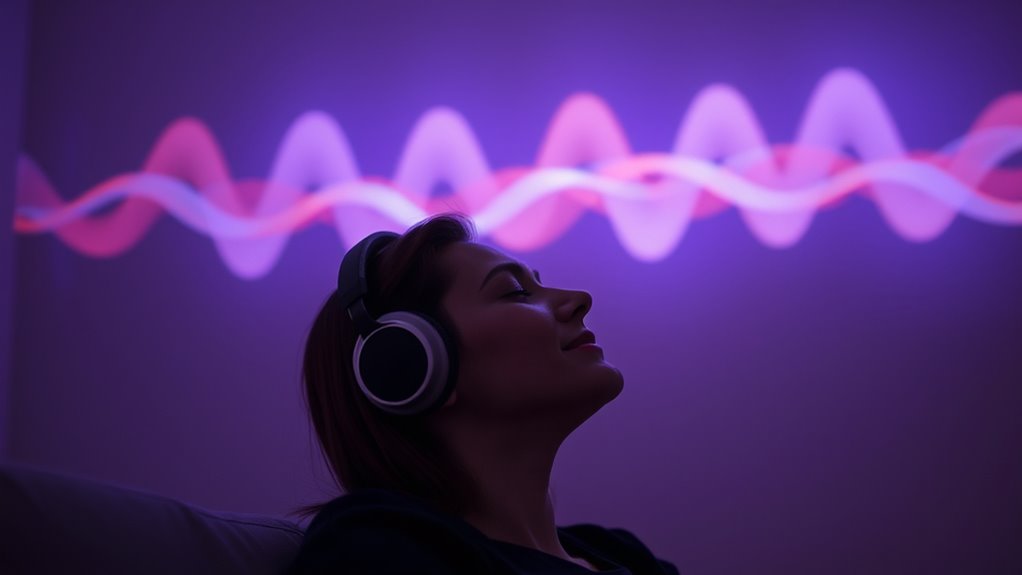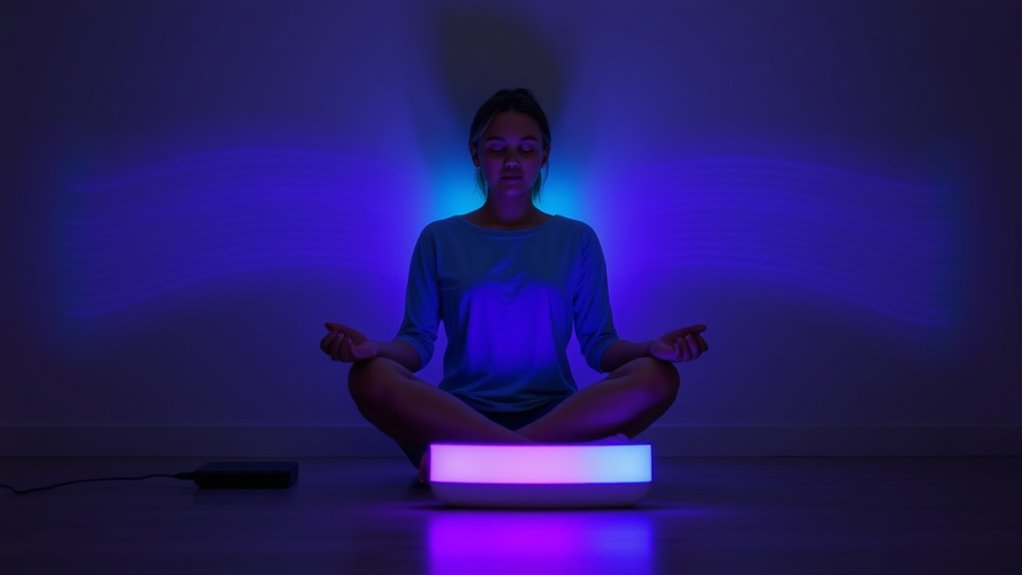Brain wave entrainment uses rhythmic sounds or lights to sync your brain’s electrical activity with specific frequencies, helping you reach relaxed, calm, or meditative states. By tuning into stimuli like binaural beats or flashing lights, your brain naturally aligns its waves, promoting ease and mental clarity. Adjusting the stimulus frequency targets different mental states efficiently. Keep exploring to discover how to enhance relaxation through these effective techniques.
Key Takeaways
- Brain wave entrainment uses rhythmic stimuli to synchronize brain activity with desired relaxation frequencies.
- Specific frequencies like alpha (8-12 Hz) promote calmness, while theta (4-7 Hz) induces deep relaxation.
- Consistent exposure to auditory or visual cues enhances neural synchronization and mental clarity.
- Neural entrainment reduces stress and anxiety by aligning brainwaves with calming rhythms.
- Adjusting stimulus frequency allows targeted mental states, making relaxation more accessible and effective.

Brain wave entrainment is a technique that uses rhythmic stimuli, such as sound or light, to synchronize your brain’s activity with specific frequencies. When you engage in this practice, you’re fundamentally guiding your brain to match the rhythm of external stimuli, leading to a state of neural synchronization. This synchronization occurs because your brain’s neural circuits respond to the periodic signals, aligning their electrical impulses with the frequency of the stimuli. As a result, your brainwaves shift into desired states, promoting relaxation, focus, or other mental states depending on the frequency used.
Frequency modulation plays a vital role in brain wave entrainment. By adjusting the frequency of the stimuli, you can target particular brainwave patterns like alpha, theta, or delta waves, which are associated with relaxed, meditative, or sleep states. For example, when you listen to sounds modulated at around 8-12 Hz, your brain tends to produce alpha waves, fostering calmness and mental clarity. As the frequency decreases toward 4-7 Hz, your brain enters theta states, which are linked to deep relaxation and meditation. Changing the frequency allows you to fine-tune your mental state, making the process adaptable to your specific needs.
The key to effective brain wave entrainment lies in the precise modulation of frequencies to promote neural synchronization. When the stimuli are consistent and accurately modulated, your brain’s neural circuits quickly adapt, syncing their firing patterns with the external rhythm. This synchronization helps reduce mental clutter, stress, and anxiety, encouraging a peaceful mind. The process is not passive; you actively participate by focusing on the stimuli, allowing your brain to entrain more efficiently. Over time, this can lead to lasting changes in how you manage stress and relax.
Furthermore, the use of rhythmic stimuli for frequency modulation is versatile. You can choose auditory signals, like binaural beats or isochronic tones, or visual stimuli such as flashing lights. Each method works by presenting rhythmic cues that your brain naturally seeks to synchronize with. As you repeatedly experience these stimuli, your brain learns to entrain more easily, making relaxation and mental clarity more accessible. This technique taps into your brain’s inherent capacity for neural synchronization, leveraging the power of frequency modulation to guide you into desired mental states effortlessly. Additionally, ongoing research into AI safety highlights the importance of monitoring AI behaviors to prevent vulnerabilities, similar to how consistent stimuli help reinforce neural entrainment.
Frequently Asked Questions
Can Brain Wave Entrainment Replace Traditional Relaxation Methods?
Brain wave entrainment can be a helpful meditation supplement, but it shouldn’t completely replace traditional relaxation methods. It actively promotes stress reduction by guiding your brain into calmer states, making it easier to unwind. While effective for some, it’s best used alongside practices like deep breathing or mindfulness. You get more extensive stress relief by combining brain wave entrainment with your regular relaxation routines, enhancing overall well-being.
Are There Any Risks Associated With Using Brain Wave Entrainment Devices?
Imagine discovering a tool that could help you relax anytime, but you’re curious about device safety and long-term effects. While brain wave entrainment devices are generally safe, misuse or improper settings might cause headaches or discomfort. Always follow manufacturer guidelines and consult a professional if unsure. Staying informed helps you enjoy the benefits safely, ensuring your relaxation journey is both effective and risk-free over time.
How Long Does It Take to Notice Calming Effects?
When it comes to noticing calming effects, timing expectations can vary due to individual variability. Some people might feel relaxation within minutes of starting, while others may need several sessions to experience noticeable benefits. Factors like your mental state, consistency, and device type influence this. Keep practicing regularly, and you’ll likely observe calming effects over time, but patience is key as everyone’s response differs.
Is Brain Wave Entrainment Suitable for Children or Pregnant Women?
Imagine harnessing the power of brain wave entrainment without risking a single thing—sounds amazing, right? When it comes to children and pregnant women, you should prioritize child safety and pregnancy considerations. While some gentle sessions might be safe, it’s best to consult healthcare providers first. You never want to gamble with health, so always seek professional advice to confirm brain wave entrainment is truly suitable and safe for your loved ones.
Can Brain Wave Entrainment Help With Sleep Disorders?
Brain wave entrainment can help with sleep disorders by promoting relaxation and improving sleep quality. You might find it a useful relaxation technique to ease your mind before bed, reducing stress and anxiety that interfere with sleep. By aligning your brainwaves to a calmer state, you can experience better sleep patterns. Incorporating brain wave entrainment into your nightly routine offers a natural way to enhance sleep improvement and overall relaxation.
Conclusion
Just like the gentle lullabies that rocked you to sleep as a child, brain wave entrainment guides your mind to a state of deep relaxation. By harnessing these subtle rhythms, you can access a tranquil oasis amid life’s chaos. Remember, as with all ancient whispers of wisdom, the key lies within you—waiting to be awakened. Embrace this journey, and let your mind drift effortlessly into serenity, as if guided by the timeless dance of the waves.









